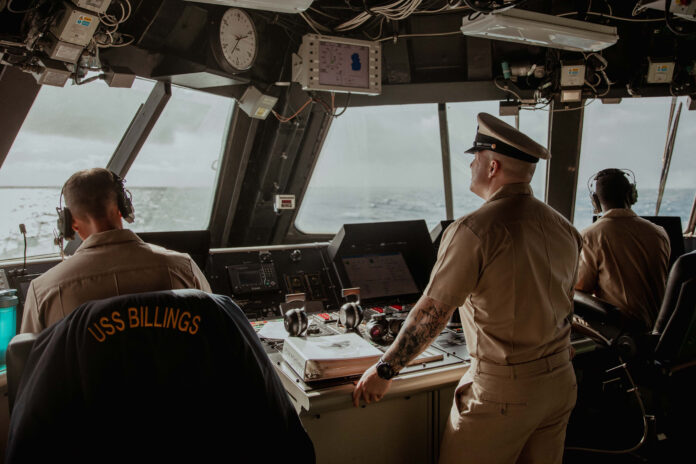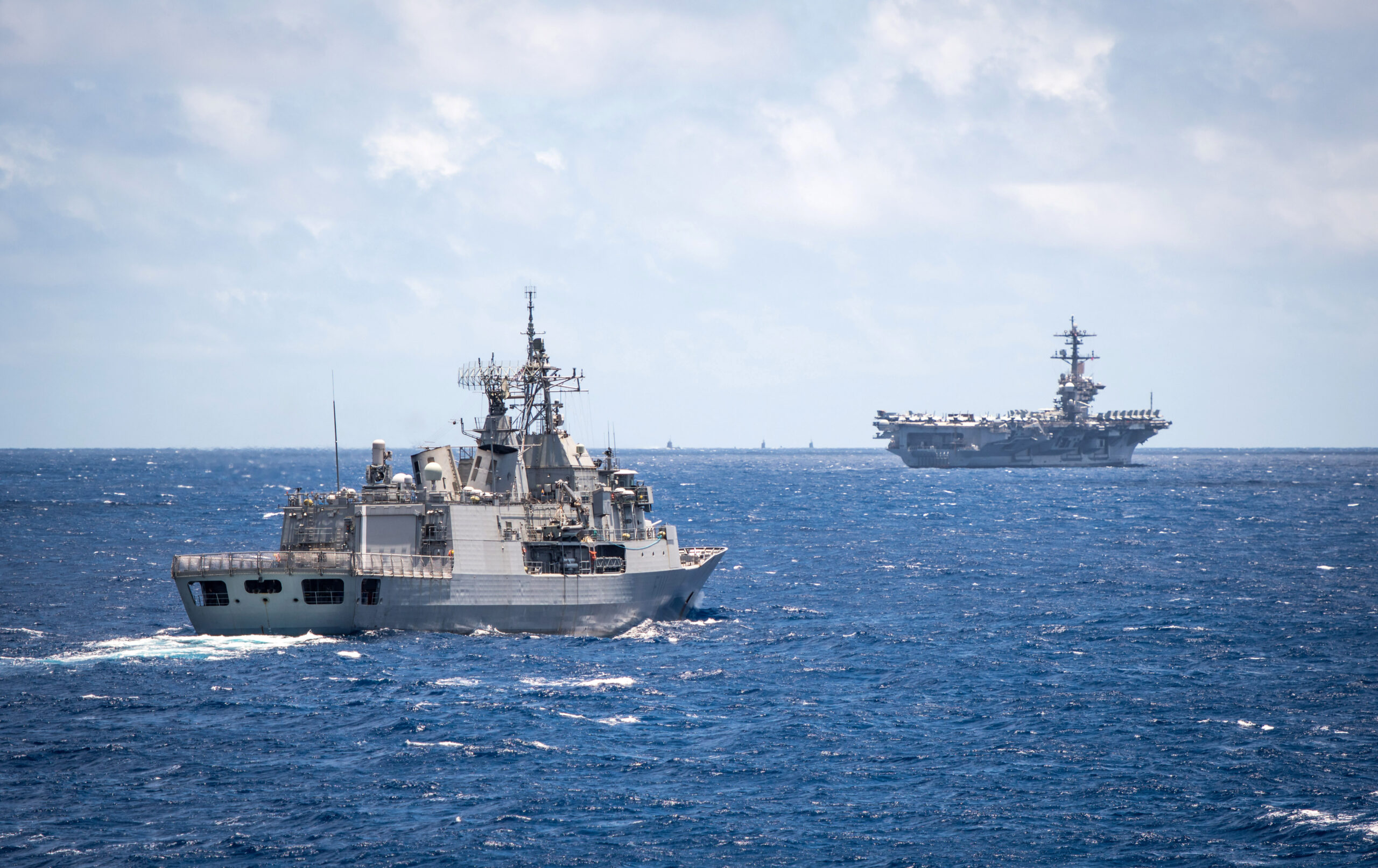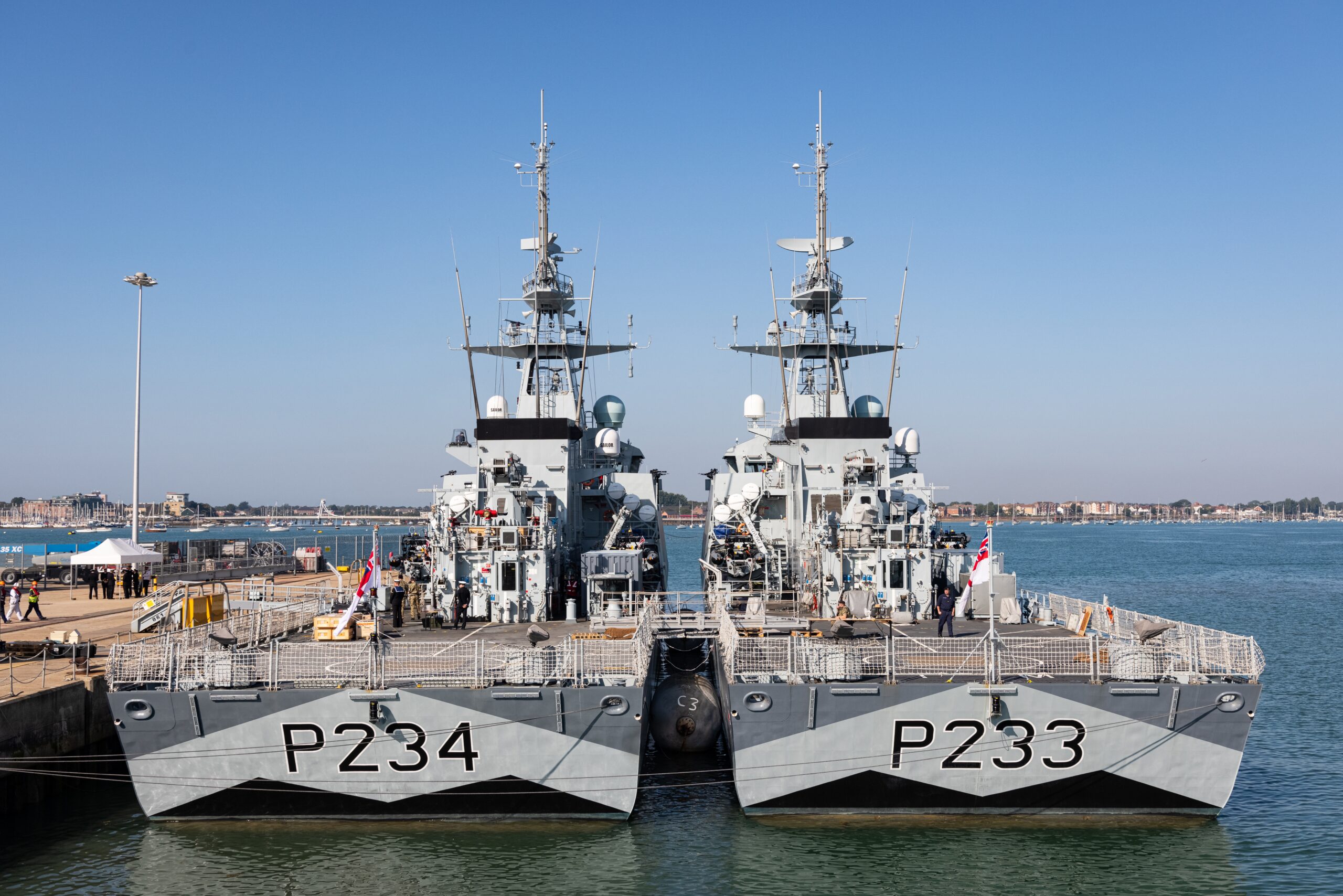
The increasing adoption of open architecture and artificial intelligence is growing the capacity of naval combat management systems.
In simple terms, naval platforms deliver military effect by detecting the presence of a potential target via the ship’s sensors, identifying and classifying the target, and (if action is required), directing weapons systems to fire and deliver their effects. This process is enabled – integrated – by the ship’s combat management system (CMS).
CMS systems were always designed to integrate sensors and weapons to deliver effect for the platform. Today, they have evolved to become an integral part of the naval operational network using open architecture and, increasingly in the future, artificial intelligence (AI), to enable them to share data and information and to support the platform’s command-and-control (C2) decision-making process.
Responsible for integrating the data provided by sensor systems and disseminating it to weapons systems, a CMS can be seen as the ‘brains’ behind the generation of a naval platform’s operational effect. A CMS combines and manages data provided by the platform’s ‘eyes and ears’ – the sensors – to provide information to guide the use of the platform’s ‘teeth’ – the weapons.
In structural terms, a CMS is a software package installed across a platform’s operating system but centred around a set of workstations located in the platform’s control room or combat information centre, the location from where a ship’s operations are managed and directed. Thus, as well as being the ‘brain’ determining how a ship delivers its operational outputs, a CMS is also the ‘heartbeat’ of that ship’s operational capability, pulsing out the operational effects it generates.
Changed effect
The two primary changes in naval warfare in recent decades that have fundamentally re-shaped the capability, if not role, of a CMS have been: the increased development of multi-role, as opposed to single-role, naval platforms; and the increased requirement for the integrated use of information to generate enhanced operational effect.
Multi-role platforms have increased in numbers since navies found it ever more difficult, in the post-Cold War ‘peace dividend’ period, to justify and afford the building of several different types of surface platform. This increase in role requirement, and the consequent need to add different ranges of sensor and weapons systems, mandated better integration within the CMS to manage these different roles, sensors, and weapons.
The changing nature of naval warfare in the information age has also changed the capability requirements for a CMS. Individual naval platforms are not only required to make more efficient and effective use of the data their sensors gather; they are also increasingly required to integrate that data with other platforms. In the era of information integration, a CMS is the hub of such integration.
In terms of this increased requirement for integrated information, the greater number of sensors – both onboard the platform itself, onboard organic platform systems operating offboard (for example, a ship’s helicopter or deployed unmanned systems), and on other platforms in the information-sharing network – have increased the amount of data available to the operator, but similarly have increased the need to process, analyse, and distribute such data, and to make decisions based on it. Thus, a contemporary CMS is required to do more to develop the data it gathers, to turn it into usable information.
Two key developments here, one now well established and one emerging, are shaping how a CMS uses such data and information. First, open-architecture approaches to developing CMS systems, as well as sensors and weapons systems, mean that a greater range of systems can be plugged in to a CMS; different CMS’ also can be connected to each other. Second, the need to make better use of the data available to inform and enable decision making is seeing navies taking advantage of the development of software-based approaches to data enhancement, notably through the increased use of automation in decision making and, particularly, the role of AI in enhancing the efficacy of decision making.

The beating brain
In this context, the development of a CMS to enable it to inform a ship command’s decision-making process rather than for it to just conduct functional actions suggests this evolution underlines the CMS’s role as the ship’s brain, rather than just its heart beat.
Writing in a white paper titled Brains of a ship: software that manages combat at sea, sensor and weapons system house Lockheed Martin stated: “In simplest terms, a naval CMS is the computer and software that integrates all of a ship’s weapons, data, sensors, and other equipment into a single system. Basically, it allows the crew to counter threats faster and more efficiently, especially during combat or security operations.”
The paper pointed out that a CMS performs four key functions: situational awareness using sensor systems to collect information about the surrounding operational environment; intelligence-gathering, by converting data gathered into actionable information; planning, by providing information to the ship’s company and decision-makers therein in a format supporting the development of plans; and command and control (C2), which links the information to the use of weapons systems to enable threat engagement and the delivery of effectors and effects.
Lockheed Martin produces a number of notable CMS products. First, and perhaps most prominent, is its Aegis combat data system, the latest variant of which is the Baseline 9 version. Aegis is deployed across the US Navy (USN) and broadly across the world, especially among navies with high-end operational capability.
Second, Lockheed Martin also has developed its CMS 330 system for the Royal Canadian Navy (RCN), Chilean Navy, and Royal New Zealand Navy (RNZN). For the RCN, its future Canadian Surface Combatant (CSC) programme will see the planned 15 future frigates fitted with an Aegis-enhanced CMS 330.
For the RNZN, CMS 330 was added to its two ANZAC Meko frigates Te Kaha and Te Mana during a Frigate Systems Upgrade (FSU) programme that was undertaken in Canada by Lockheed Martin Canada, between May 2018 and August 2021. According to Lockheed Martin, “These upgrades provide the ship with a greater degree of survivability through a faster decision-making process and response to a variety of threats.” In March 2022, the New Zealand Defence Force noted that Te Kaha had been working up back in New Zealand since 2021 and Te Mana was scheduled to leave Canada in mid-2022 following completion of post-upgrade system testing and trials.

Third, Lockheed Martin has derived the Aegis weapon system to develop COMBATSS-21, a CMS that contains in-built access to a Common Source Library (CSL). According to Lockheed Martin, CSL is “a software repository that allows for sharing and re-use of code, without an additional cost. This way, when software is developed, debugged, or upgraded, it can quickly be released across a fleet, similar to how smartphones receive app updates”.
COMBATSS-21 is based around an open architecture construct to allow CMS capabilities to be tailored to the platform in question and to allow software upgrades to be integrated when available. In its CMS paper, Lockheed Martin COMBATSS-21 programme manager David Kugler said, “With the CSL, as sensors and weapons evolve, the software that supports them requires minimal development and minimal crew training in order to adapt to new interfaces”.
COMBATSS-21 is installed in the USN’s Freedom-class Littoral Combat Ship (LCS) programme, with the CMS planned also to be installed in the ‘sister’, Independence-class LCS programme.
Based around an open architecture construct that enables rapid technology insertion and response to emerging threats, and around CSL technology that enables commonality across surface platforms, COMBATSS-21 “allows for the seaframe integration of advanced radars, missiles, and launchers, which increases the lethality of smaller ships,” said Lockheed Martin. COMBATSS-21’s Aegis derivation is also key to its effective integration, the company added: “By integrating an Aegis-derived system on new ships, the USN [for example] will be able to leverage the knowledge of sailors already skilled to operate Aegis. Existing Aegis training programmes can prepare sailors to operate components of COMBATSS-21. Now, sailors can come off an Aegis destroyer or cruiser, and board an LCS with a high level of familiarity with the system they need to operate.”
COMBATSS-21 is also based around a modular software design. According to Military Aerospace magazine, this means “COMBATSS-21 can run on computer configurations ranging from one commercial processor running a commercial operating system to more distributed configurations, making the COMBATSS-21 system adaptable to vessels ranging from patrol craft to large-deck ships.”
COMBATSS-21 is understood to be considered as the CMS capability for the USN’s Constellation-class FFG(X) future frigate. It is also demonstrating appeal beyond just the USN. In December 2021, the US Defense Security Co-operation Agency (DCSA) announced that the US Department of State approved a possible Foreign Military Sales (FMS) case for a multi-mission surface combatant (MMSC) to Greece, as part of the US submission for a Hellenic Navy competition for the modernisation of its frigate force. The proposed US package included, alongside four MMSC platforms, five COMBATSS-21 CMS systems (with four to be fitted and one to be spare). The US MMSC concept is a derivate of the USN’s LCS Freedom-class design.
COMBATSS-21’s evolution as a prospective international naval CMS is not a new development. In October 2015, the DCSA noted that the US State Department had approved possible sale of four MMSC platforms to Saudi Arabia. Again, the package included five COMBATSS-21 kits (four as fits, one as spare). The sale was formally agreed in May 2017, with a contract signed in December 2019. The first two, of what are known formally as the Saud-class frigates, are in build.

Intelligent integration
The BAE Systems INTeACT CMS is another example of an emerging family of CMS capability, with INTeACT being the ‘umbrella term’ under which BAE Systems’ CMS product lines are now developed.
As well as being based around open architecture capability, INTeACT is also an example of a CMS programme that is seeking to integrate AI capability into CMS.
In CMS operation, AI is used to help distil information from data, to disseminate the right information to the right user, and to prioritise such information to support the user’s decision making.
According to BAE Systems, its next-generation INTeACT products – which build upon the DNA/CMS-1 CMS set-ups installed in the UK Royal Navy’s (RN’s) Type 23 Duke-class frigates, Type 45 Daring-class destroyers, Forth-/River-class Batch 2 offshore patrol vessels (OPVs), and Queen Elizabeth-class aircraft carriers – “provides warship crews with all the information they need to track, analyse, and respond to threats in combat, as well as the ability to co-ordinate resources in other operations such as intelligence gathering and humanitarian assistance, both independently or as part of multinational coalitions”. The open-architecture construct enables rapid adaptability and integration to enhance capability, including through adding other software applications.
The addition of software applications is itself enabled by INTeACT’s Software Development Kit (SDK) concept. According to BAE Systems, SDK is an open interface-based set-up that includes software libraries and other tools to enable development and integration of new applications. SDK’s initial focus is on integrating applications that address tactical picture visualisation and elements of tracking capability.
Indeed, tracking capability is a central element of the INTeACT SDK capability. According to a September 2020 BAE Systems paper, the INTeACT SDK Combat System Track Service “provides a consolidated view from multiple sensors and decision aids”, with a ‘Combat System Picture Correlation App’ determining “whether tracks from different sensors correspond to the same object”.
As well as providing a fused tactical picture to support real-time maritime situational awareness, and using open architecture to enable integration of various sensors and effectors, INTeACT SDK also incorporates autonomy and AI into its structure and outputs.
Reflecting the range of platforms that predecessor UK CMS systems were fitted across, BAE Systems stated that INTeACT CMS is relevant for ships ranging from patrol vessels to aircraft carriers. According to the company, INTeACT SDK also “delivers an open [architecture] approach that meets the needs of the RN’s vision for future combat systems”.
by Dr Lee Willett












